PinotFile: 12.7 June 14, 2020
|
RAEN WineryFourth-generation winegrowers, Carlo and Dante Mondavi founded RAEN (Research in Agriculture and Ecology Naturally) in 2013 with the goal of producing world-class Pinot Noir and Chardonnay from three distinct hillside coastal vineyards in West Sonoma County. The pair learned the wine business from grandfather Robert and father Tim. Tim was a pioneering producer of California Pinot Noir in the early 1970s. Three Pinot Noir wines are offered from three vineyards (north to south): (1) Fort Ross-Seaview Home Field Vineyard Sonoma Coast Pinot Noir (going forward known as Sea Field Vineyard) from a site located just north of Jenner overlooking the Pacific Ocean, (2) Freestone Occidental Bodega Vineyard Sonoma Coast Pinot Noir and (3) Royal St. Robert Cuvée Sonoma Coast Pinot Noir.
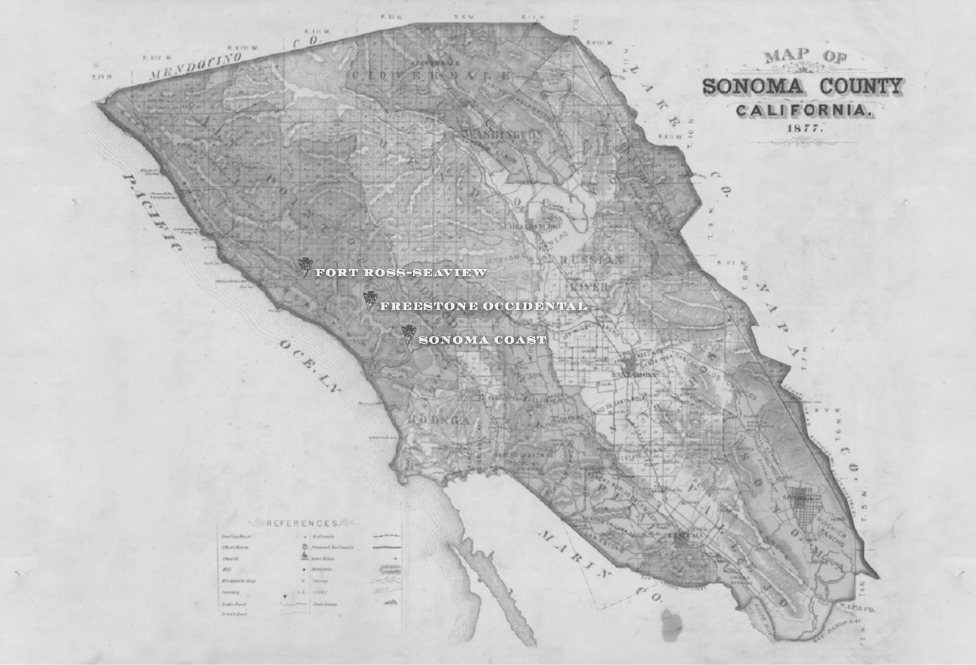 Fort Ross-Seaview Vineyard is located at 1,025-1,270 feet elevation less than 2 miles from the Pacific Ocean. The 4.8 acres contains soil that is decomposing iron-rich sandstone of the Franciscan series. Clone 777 is planted here near David Hirsch’s property. Freestone Occidental Vineyard is the winery’s coolest daytime site. This 1.8-acre vineyard is surrounded by redwoods and native grasses. It is located just east of Bodega Bay between the small towns of Freestone and Occidental. This westerly planting is one of the oldest meter-by-meter plantings of Pinot Noir on the Sonoma Coast. Elevation is 750 feet and the soils are Goldridge sandy loam and iron-rich Franciscan. The clones planted are 667, Calera and Pommard. Sonoma Coast Royal St. Robert (RSR) Vineyard fruit is located near the village of Freestone and Joseph Phelp’s Freestone project overlooking Bodega Bay and the Sonoma coastline, Summer mornings are characterized by pacific fog engulfing the vines, receding in the late morning when the vines become drenched in afternoon sunlight to ripen the fruit. 10 acres of Pinot Noir plantings include Calera, Pommard, “828,” VR1 and 667. The elevation is 659 feet. Soil is Goldridge sandy loam with the upper parcel iron-rich Franciscan. The Cuvée is a barrel selection bottling. A Chardonnay is sourced from the Charles Ranch Vineyard located in Fort Ross-Seaview AVA of the West Sonoma Coast. Very limited production each year. The 2018 vintage is the third release. Charles Ranch was the second vineyard to be planted in the Fort Ross-Seaview AVA. George Charles Martinelli planted it at a time when many people thought that grapes could not ripen out there. The Ag Commission did not want to give George a permit to plant because they did not believe grapes would grow out there in the cooler weather. He did it anyway. Budwood planted in 1982 is Wente and 04 on AxR and St. George rootstock in well-drained Josephine and Goldridge soil. Both Carlo and Dante are involved in the winemaking (although Dante is listed as the winegrower on the label) with input from winemaker Kristof Anderson of Scribe. The wines offer whole cluster aesthetic, a minimum of new oak and very modest alcohol levels. A 2019 RAEN The Monarch Challenge Rosé is also produced ($28). The wines are eagerly sought after and highly allocated to a mailing list at www.raenwinery.com. Tasting is by appointment. Members of the RAEN Society are guaranteed one automated yearly shipment of the limited production wines (less than 1,000 cases annually). Various allocation levels are offered. Each spring, large formats are released. For 2018, 60 magnums and 7 double magnums were released. Production is in Sebastopol. Word on the street is that they are looking to cquire property on the Sonoma Coast to open an intimate tasting room. Follow at www.facebook.com/raenwinery/. This young winery is offering Pinot Noir par excellence and has me hooked.
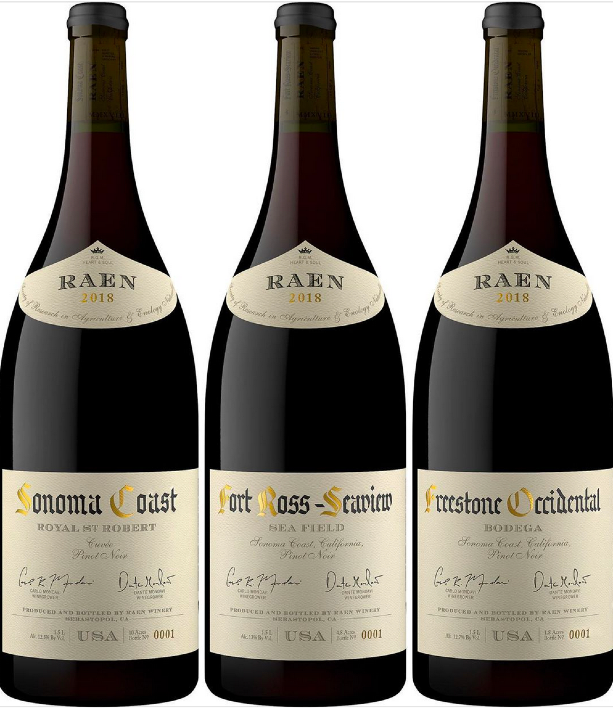 2018 RAEN Fort Ross Seaview Sea Field Sonoma Coast Pinot Noir 13.0% alc., $80. · Moderate garnet color in the glass. Aromas of dark cherry, boysenberry, subtle oak and salt air draw you in. The mid weight core of black cherry and blackberry fruits are framed by moderate tannins the most of the three 2018 RAEN Pinots). There is a slight herbal tone. The dry finish is very long and dripping with fruit. The wine is most agreeable when tasted two days after opening indicating age ability. Score: 94
2018 RAEN Freestone Occidental Sonoma Coast Pinot Noir 12.7% alc., $90. · Moderately dark garnet color in the glass. Aromas of underbrush, potpourri and floridity present initially with dark fruits chiming in over time in the glass, culminating in a glorious experience. Well-bred medium weight flavors of black cherry and blackberry are accented with a subtle dried herb note. A delightful wine with a rich middle palate, gracious harmony and a creamy mouthfeel. The finish is intensely fruity and remarkably long like a 3-hour movie you don’t want to end. Simply delicious and still engaging two days after opening. Score: 96
2018 RAEN Sonoma Coast Royal St. Robert Pinot Noir 12.5% alc., $70. A special bottling dedicated to Robert Mondavi. A selection of the finest barrels. · Moderately dark garnet color in the glass. The nose is more expressive over time in the glass. revealing aromas of dark cherry, burnt tobacco and dried herbs. Soft in the mouth and relatively light in weight, offering fruit flavors of black cherry and black raspberry with an underpinning of dried herbs and smoky oak. Very fine-grain tannins make for easy approachability, but the wine picks up more fruit intensity and finishing length over time. Score: 91
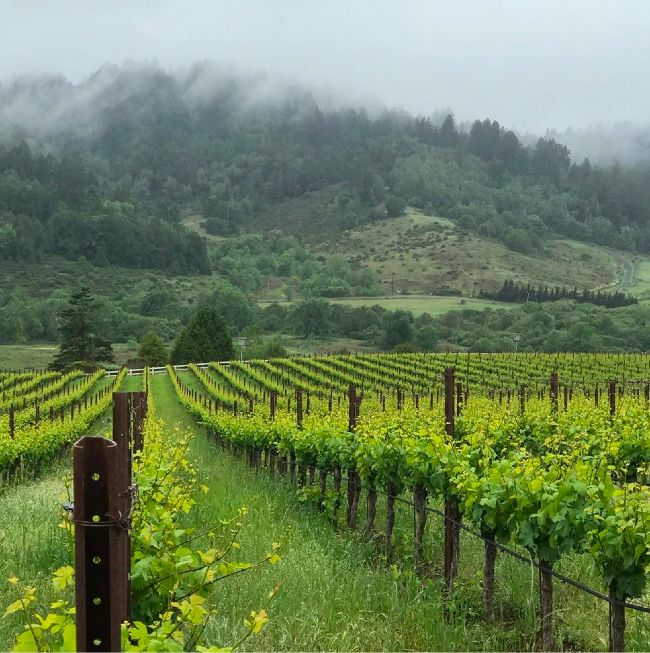
2018 RAEN Charles Ranch Fort Ross-Seaview Sonoma Coast Chardonnay 12.5% alc., $65. Pre-phylloxera hillside Chardonnay plantings less than two miles from the Pacific Ocean. · Light golden yellow color in the glass. A complex nose displays scents of lemon curd, pineapple, white flower blossom, warm pastry and a compliment of oak. An expressive core of lemon-lime and pineapple fruit flavors is nicely paired with spirited acidity that walks the line between a fruity Chardonnay and a lean, crisp style. The slightest viscosity adds a desirable texture and and the finish offers a refreshing grip of acidity. Score: 94
Albatross Ridge
Wine Enthusiast
In the 1930s, famed engineer and pilot William Hawley Bowlus, whose pioneering Albatross sailplanes are in the Smithsonian, used to fly gliders off the ridges of Monterey’s Carmel Coast. Decades later, his grandson and great-grandson, Brad and Garrett Bowlus, unknowingly came to the same mountain slopes to establish a vineyard. Researching the history of Monterey, they found a photo of Hawley Bowlus launching his Albatross sailplane off the same high mountain slopes where they found their vineyard site.
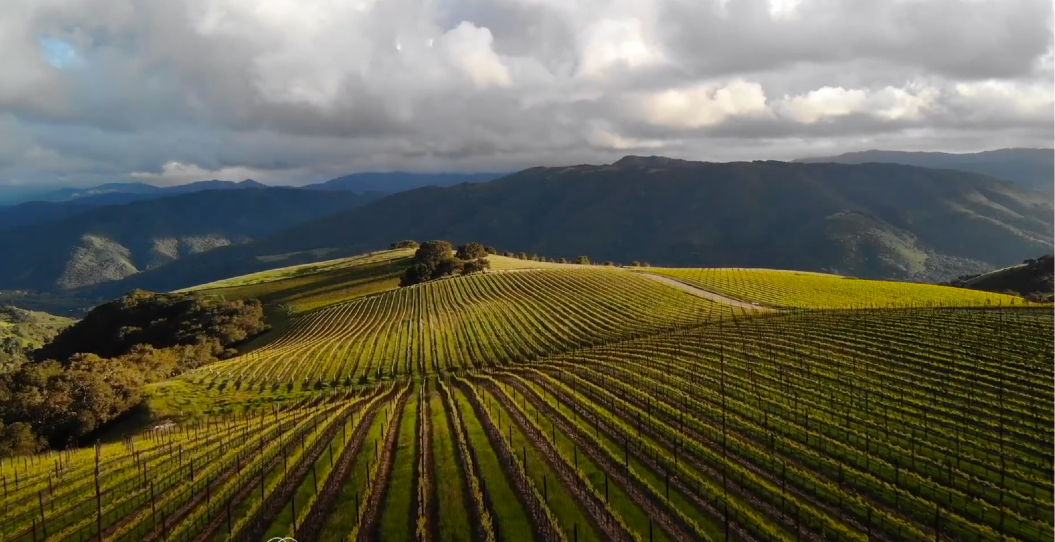 The vineyard is located just seven miles from the Pacific Ocean and overlooks Carmel Bay in the distance with elevations reaching up to 1,250 feet. What drew them to the vineyard site initially was the very mild temperatures (normal daytime highs averaging between 65-75 degrees) and the low-vigor, uplifted rocky diatomaceous seabed, limestone and shale soils, similar to those found in Burgundy, ideal for growing Pinot Noir and Chardonnay. Annual growing days between 1650 and 1950 GDD make this vineyard one of the coolest sites to ripen Pinot Noir and Chardonnay anywhere in the world. Winemaking is headed up by Garrett Bowlus Pinot Noir vinification includes 20%-30% whole cluster and native yeast fermentations. Aging is in 30%-50% new French oak and the wines are bottled unfined and unfiltered. Chardonnays undergo whole cluster pressing, native fermentation sur lees in concrete with no stirring or racking and full native malolactic fermentation. 50% aged 12 months in French oak barrels (25% new) and 50% aged 12 months in a total concrete vertical tank. Case production has increased from 1,000 cases to over 4,000 cases currently. In the fall of 2019, production began in a new winery in Marina, California. A tasting room is located in Carmel-By-The-Sea and a second tasting room was slated to open in Carmel Village in early summer of 2020. Albatross Ridge wines are available on the winery’s website at www.albatrossridge.com.
2018 Albatross Ridge Cuvée Vivienne Carmel Valley Monterey Pinot Noir 13.0% alc., pH 3.68, 600 cases, $45. This bottling is named after the winemaker’s daughter and was sourced from 8 blocks of the estate vineyard. Clones “828,” Pommard, 115 and 777 yielding 1.55 tons per acre. Harvest Bris 21.5º-23.7º. 20% whole cluster. Aged 12 months in French oak barrels, 30% new. Bottled unfined and unfiltered. · Moderately dark garnet color in the glass. Nicely perfumed with aromas of cherry, rose petal and the slightest oak. A satisfying wine with up front appeal in a mid weight style featuring black cherry and purple berry flavors with a hint of smokiness in the background. Nicely balanced, with fine-grain tannins and a credible finish. Score: 90
2018 Albatross Ridge Estate Reserve Carmel Valley Monterey Pinot Noir 13.0% alc., pH 3.65, 600 cases, $68. A barrel selection of the finest barrels of the vintage. Clones “929,” Pommard, 115 and 777 picked at 1.55 tons per acre. Harvest Brix 22.5º-23.5. 30% whole cluster. Aged 12 months in French oak barrels, 40% new. Bottled unfined and unfiltered. · Dark garnet color in the glass. Reserved but pleasant aromas of cherry, blueberry, spice and rose petal. A bold, mid-weight plus style that floods the mouth with black cherry and black raspberry goodness. Satiny in texture with gracious tannins and an appealing compliment of oak. A fruit-driven wine showing excellent harmony. Score: 92
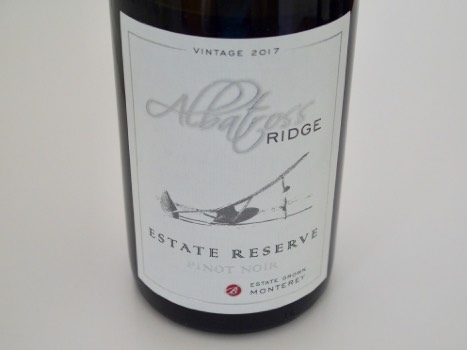 2017 Albatross Ridge Estate Reserve Carmel Valley Monterey Pinot Noir 13.0% alc., pH 3.50, $68. Clones “828,” Pommard, 115 and 777 harvested at 1.25 tons per acre and a harvest Brix of 21.0-23.5º. 20% whole cluster. Aged 19 months in French oak barrels, 33% new. Bottled unfined and unfiltered. · Moderate garnet color in the glass. Uplifting aromas of dark cherry, dried herbs and oak vanillin. An intensely fruity wine in a mid-weight plus style that features a vibrant core of black cherry and blackberry fruit. Juicy, with tame tannins and fruit that really clings to the feature. Still fine when tasted the following day from a previously opened and re-corked bottle. Nothing but good things to say. Score: 93
2017 Albatross Ridge First Flight Carmel Valley Monterey Pinot Noir 13.0% alc., pH 3.52, 100 cases, $115. Clones “828,” and Pommard harvested at 1.25 tons per acre. Harvest Brix 22.0º-23.5º. 30% whole cluster. Aged 16 months in French oak barrels, 50% new. · Moderately light garnet color in the glass. Aromas of dark cherry, underbrush, vanilla and campfire embers. A sappy wine with waves of black cherry and blackberry fruit with a whack of smoky, herbal oak in the background. The wine does have a congenial mouthfeel and some length on the finish, but I wish for more Pinot than oak perfume. Score: 88
2018 Albatross Ridge Estate Carmel Valley Monterey Chardonnay 13.0% alc., pH 3.23, 450 cases, $68. Clones 96 and 15 harvested at 1.53 tons per acre and a harvest Brix of 20.0º-23.5º. · Moderate golden yellow color in the glass. Subdued aromas of lemongrass, bruised apple, straw and wet oak. Slightly viscous in the mouth offering flavors of lemon and yellow peach. There is some persistence on the finish, but overall the wine lacks inspiration and crispness. Score: 89
2017 Albatross Ridge First Flight Carmel Valley Chardonnay 13.0% alc., pH 3.20, $95. Clones 96 and 15 harvested at 1 ton per acre and a harvest Brix of 23.3º. Aged 16 months in 90% new French oak barrels and 10% in a concrete vertical tank. · Light golden yellow color in the glass. Engaging aromas of lemon curd, wildflower honey, moist ocean air, vanilla and a hint of matchstick. Bright flavors of lemon-lime and pineapple with a gentle overcoat of oak. Delicious fruit flavors paired with mouthwatering acidity and judicious oak in the background. This beauty literally dances on the palate. Score: 94
Latest Releases of Gary Farrell Pinot Noir
If you want to hang your hat on a top-notch producer of Pinot Noir and Chardonnay, you couldn’t do better than Gary Farrell Vineyards & Winery. Gary Farrell’s legacy lives on in the capable hands of winemaker Theresa Heredia, who joined the winery in 2012 and has raised the quality of the wines to new heights, capturing the bright perfume, supple flavors and acid-driven freshness of Pinot Noir that connoisseur’s dream about. The Chardonnays are of equal acclaim, sourced from the Russian River Valley’s top vineyards including Rochioli, Bacigalupi and Ritchie. I have written extensively about this winery and reviewed many wines dating back to 2004: www.princeofpinot.com/winery/420/. The Gary Farrell style is easily recognizable: fresh, vivid, juicy with minimal tannins and a grip of refreshing acidity on the long finishes. The winery’s Russian River Valley Selection Pinot Noir and Chardonnay are widely distributed while the vineyard-designates are sold primarily to wine club members and those who visit the winery to taste (by appointment). Inquiries at www.garyfarrellwinery.com. The Sip and Savor Through Sonoma tasting taking place via Zoom is a terrific interactive experience that includes a tour, tasting and food pairing.
2017 Gary Farrell Bien Nacido Vineyard Santa Maria Valley Pinot Noir 13.3% alc., $70. One of the few wineries to source Pommard clone from the legendary Q Block, considered the most prestigious Pinot Noir block on this famous vineyard. · Light garnet color in the glass. The scent of dark red cherry and berry, oak spice and floral perfume leads to a mid-weight infusion of oak-kissed Bing cherry and dark strawberry fruit flavors. Fresh and satisfying without noticeable tannins, silky in texture, and offering an arrow of acidity that drives a lip-smacking, extended finish. Tasted twice, Score: 93
2017 Gary Farrell Martaella Vineyard Russian River Valley Pinot Noir 13.2% alc., $65. Released May 2020. Exclusive Wine Club Release. · Moderate garnet color in the glass. Aromas of earth-bound cherry, blueberry, purple grape, dried herbs and bark. Lighter weighted and elegant with an expressive core of dark red cherry fruit that enlightens the mid palate and carries through to a regal, long finish. A very open and giving wine with a silky mouthfeel, well-integrated oak and a lip-smacking finish. Score: 92
2017 Gary Farrell Rochioli-Allen Vineyard Russian River Valley Pinot Noir 13.3% alc., $80. Exclusive Wine Club Release, May 2020. Sourced from the renowned Rochioli Vineyard and Allen Vineyard, both farmed by the Rochioli family. The blend is composed primarily by a Pommard selection from the old 1974 and new 1996 Allen Vineyard North Hill blocks and the balance is Pommard from the Rochioli Vineyard. · Moderately light garnet color in the glass. Alluring fragrance of Bing cherry, strawberry, baking spice and worn leather. Fresh and juicy on the palate in a mid-weight style featuring a charge of dark cherry and raspberry fruit flavors. Silken tannins and uplifting acidity with a faint compliment of oak in the background. Less sap than the Hallberg bottling but more finesse and demure charm. Like biting into a ripe cherry. Score: 93
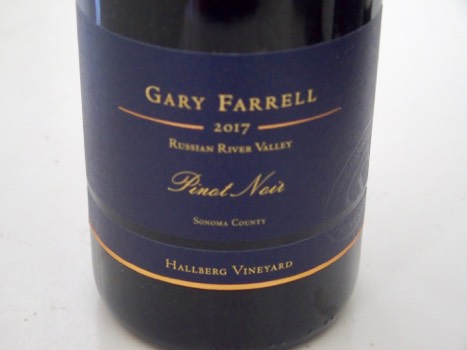 2017 Gary Farrell Hallberg Vineyard Russian River Valley Pinot Noir 13.8% alc., $55. 100-acre vineyard nestled in the Green Valley of Russian River Valley. A blend of many of the best blocks on this cool, foggy vineyard site including clones 667, 777, “828,” Pommard and a suitcase selection. · Moderate garnet color in the glass. Terrific array of aromas including black cherry, blackberry, red rose petal, cardamom spice and a hint of vanilla. The impressive harmony strikes a chord with the first sip. Mid-weight plus flavors of dark cherry and raspberry that stand out for their freshness. A big mouthful of fruit let lithe on the palate with fine-grain tannins and amazing fruit intensity that lingers on the finish. Score: 94
Brewer-Clifton Hapgood Mini-Vertical
Veteran winemaker Greg Brewer recently made available a Hapgood Pinot Noir Vertical Three-Pack ($225) and I tasted the 2015, 2016 and 2017 vintages. My interest was piqued by a 100-point rating given to the 2015 vintage by Doug Wilder of the Purely Domestic Wine Report. This publication focuses on producers in California, Oregon and Washington exclusively and is published quarterly by subscription. Wilder launched his publication in 2011 after a twenty-year career as a speciality wine buyer for domestic retailers. The publication is at www.purelydomesticwinereport.com. 100-point ratings for domestic Pinot Noir are extremely rare. Robert Parker, Jr. has given out many 100-point ratings but only bestowed that mark of perfection on three domestic Pinot Noirs from a single producer: 2010 Peter Michael ‘Clos du Ciel’ Sonoma Coast Pinot Noir and 2010 and 2012 Peter Michael ‘Ma Danseuse’ Sonoma Coast Pinot Noir. Wine writer and critic Steve Heimoff awarded 100 points to the 1991 Williams Selyem Hirsch Vineyard Sonoma Coast Pinot Noir, the 2007 Williams Selyem Litton Estate Russian River Valley Pinot Noir and the 2010 Williams Selyem Hirsch Vineyard Sonoma Coast Pinot Noir. I don’t believe an Oregon Pinot Noir has ever been awarded 100 points.
"There is no such thing as a 100-point wine.”
I have drunk domestic Pinot Noir long before it ever became fashionable and was fortunate to live through the modern renaissance of North American Pinot Noir. Even though many of the Pinot Noir wines I have tasted were revelations, even epiphanic, I never awarded one Pinot Noir the mark of perfection, that is, 100 points. I don’t believe perfection is ever achieved although an increasing number of domestic Pinot Noirs come darn close. As Yogi Berra would say, “If Pinot Noir were perfect, it wouldn’t be.” Perfection in Pinot Noir is simply not achievable because it doesn’t exist. But if we chase perfection, the end result is perfectly enough. The words of the legendary football coach, Vince Lombardi, ring true for me, “Perfection is not attainable, but if we chase perfection we can catch excellence.”
Brewer-Clifton was founded in 1995 by two young winemakers, Greg Brewer and Steve Clifton (and Steve’s spouse Chrystal), who decided to dedicate their new label to single-vineyard Pinot Noir and Chardonnay at a time when many Santa Barbara wineries were concentrating on varieties blended from multiple sources. They started with their combined meager savings and began producing their wines in the unglamorous Lompoc “Wine Ghetto.” They hit pay dirt in 2002 when Robert Parker, Jr. reviewed their wines from the 2001 vintage and proclaimed that the Brewer-Clifton wines were “the single greatest revelation of his 2001 tastings. The wines have always featured a full-throttle California style, driven by very ripe prodigious fruit and high alcohol. There is an emphasis on whole cluster fermentation with a focus on ripening stems alongside the fruit. The result is earthy, dense, bold Pinot Noir that can obscure the whole cluster aesthetic but provides age ability. The winery advises that the wines are produced with the intention of aging and cellaring for at least 10 years and can be easily enjoyed after 15 years. Vineyard sites in the Sta. Rita Hills AVA have always been carefully chosen and the emphasis has been placed on the vineyard as the ultimate determination of wine quality. Since 2012, the winery has only used fruit from 60 acres of estate vineyards within the AVA. In 2015, while celebrating the winery’s 20th vintage, the owners announced that they had sold a majority (70%) share in their winery to a group of investors. the goal of the sale was to use the new capital to maintain the brand’s quality, continue vineyard development and use the financial and business acumen of the new partners. In 2017, the winery was acquired by Jackson Family Wines Greg Brewer continues as the winemaker while Steve Clifton has left the winery to found his own label, La Voix, that specializes in vineyard-designated Pinot Noirs. Hapgood Vineyard is planted to Mt. Eden clone 37 with the most recent installation in 2010. The budwood was originally sourced from Merry Edwards. The clay loam content of the soil results in a dense palate expression. The winery’s lineup of Pinot Noir and Chardonnay (10,000 cases annually) is allocated through a mailing list with some wines available only to Foundation Club Members. Some collections are currently available on the website at www.brewerclifton.com. The winery’s tasting room is open daily in Los Olivos.
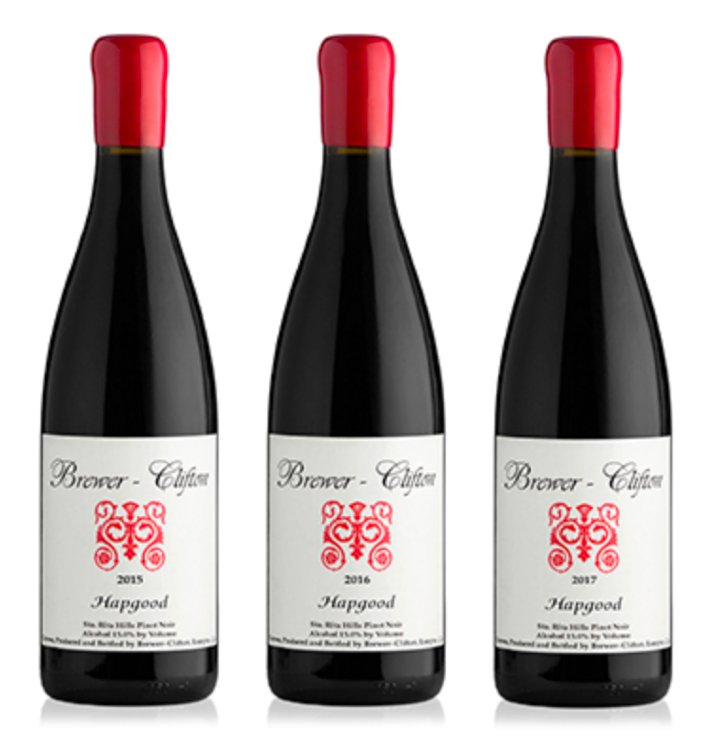
2015 Brewer-Clifton Hapgood Sta. Rita Hills Pinot Noir 15.0% alc., 200 cases. · Moderate garnet color in the glass. Aromas of blackest cherry, earthy flora, oak spice and Herbes de Provence. Both earth and oak accent the hearty core of black cherry and boysenberry fruit that is framed by mild fine-grain tannins. There is a hint of tobacco and mocha. Silky in texture, with some length on the finish. When tasted the following day from a previously opened and re-corked bottle, the earth and oak tenor of the fruit persisted. Score: 92
2016 Brewer-Clifton Hapgood Sta. Rita Hills Pinot Noir 15.5% alc., 75 cases. · Moderate garnet color in the glass. The nose offers aromas of blackest cherry, black raspberry, dried herbs and burnt tobacco. Mid-weight in concentration, featuring well-ripened, earth-toned black fruits with a modicum of oak in the background. Fruitladen, with mild tannins, good brightness and a sappy finish. Similar when tasted from a previously opened and re-corked bottle the following day. A hint of warmth appears on the finish as the wine warms in the glass. Score: 92
2017 Brewer-Clifton Hapgood Sta. Rita Hills Pinot Noir 15.0% alc., 100 cases. · Moderate garnet color in the glass. Aromas of blackberry, pomegranate and oak-driven toast and tobacco. Mid-weight plus in heft, offering an onslaught of ostentatious, spicy purple and black fruits, yet sleek, polished and very agreeable in the mouth. There is more tannins evident but they are entirely supportive. The wine sports impressive length on the generously fruity finish. Still enjoyable when tasted the following day from a previously opened and re-corked bottle. This wine needs more time in the cellar. Score: 93
Briefs
On the Lookout for Quality Modestly-Priced Pinot Noir The 2017 Big Table Farm Willamette Valley Pinot Noir is a real charmer at a modest $45 price. Released a year ago, winemaker Brian Marcy blends fruit from all the Northern Willamette Valley vineyards that he works with. The wine is more affordable than other Big Table Farm Pinot Noirs because more of it is made (2,509 cases) while receiving the same care and handling as the rest of his wines. I rated the wine 91, saying “a complex nose reflecting whole cluster fermentation….a wine of character, sleek, with good energy….even age-worthy to allow the whole cluster tannins to ameliorate.” Wine Spectator 91, Wine Enthusiast 93, Wine & Spirits 94. Available at www.bigtablefarm.com and www.klwines.com ($39.95). Ominous News for Wine Lovers The calamitous effects of the COVID-19 virus ensure that the domestic wine industry will suffer. Sonoma County alone contributes $57.6 billion to the California economy according to the Wine Institute. The U.S. has more than 10,000 wineries, 450 of them located in Sonoma County, producing $23.5 billion in total annual sales. Wine company executives and industry analysts say that not all the wineries will survive beyond COVID-19. Two New AVAs in Oregon’s Willamette Valley The TTB has approved two new AVAs in the Willamette Valley: Tualatin Hills and Laurelwood District. The name of these AVAs will first appear on labels of wines produced in 2020. The two new AVAs lie within the existing Willamette Valley AVA, while the Laurelwood District is also located in the Chehalem Mountains AVA, just to make things more complicated. The Willamette Valley AVA now has 9 smaller sub-AVAs within it. The Tualatin Hills AVA is characterized by Laurelwood soils with almost no volcanic or marine sedimentary soils, as well as elevation and climate. The distinguishing feature of the Laurelwood District AVA is also Laurelwood soils but the Laurelwood District’s soils are loess combined with basalt that is older than that found in the Tualatin Hills soil. Confused yet? For most consumers, these AVA distinctions remain mysterious. I believe the “Willamette Valley AVA” is the most powerful marketing tool for Oregon vintners. Recommended Reading An article titled “Wine & Medicine: An Enduring Historical Association appeared recently at www.guildsomm.com. This is a 15-minute read that presents a thorough summary of the history that links wine and medicine. British Columbia Assuming Pinot Noir as its Signature Grape Although more than 80 grape varieties are planted in British Columbia, Pinot Noir is becoming the signature grape among the region’s red wine varieties. Pinot Noir is widely planted in the Okanagan with the majority of vineyards less than 20 years of age. More attention to British Columbia has come via the annual B.C. Pinot Noir Celebration that was launched in 2013. Read more at www.theglobeandmail.com/life/food-and-wine/article-british-columbia-isauditioning- pinot-noir-as-its-signature-grape/. Knudsen Vineyards Opens The Outlook in the Dundee Hills Knudsen Vineyards opened its doors for the first time to the public on June 8 with a new tasting room on Worden Hill Road. The Outlook at Knudsen Vineyards is housed in the former Knudsen Erath Winery, offering tasting flights, a picnic package and an immersive hiking experience. The tasting room is open daily by appointment only with reservations available online at www.knudsenvineyards.com. All Knudsen Vineyards Pinot Noirs and Chardonnays are estate grown from the LIVE certified and Salmon Safe site and are made by winemaker Nate Klostermann. I highly recommend the wines. Wine Girl is a Book About Equality At the Right Time Victoria James became America’s youngest sommelier at age 21 and writes about the challenges she faced in the memoir, Wine Girl: The Obstacles, Humiliations and Triumphs of America’s Youngest Sommelier. She fought her way through discrimination, sexual harassment and even sexual assault and maintained her passion for restaurant hospitality. The book exposes the fact that the #MeToo movement has not gone far enough to break up the old boys of the restaurant wine world. Hardcover, 256 pages, $27. |